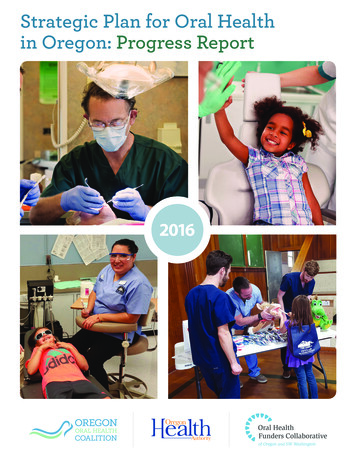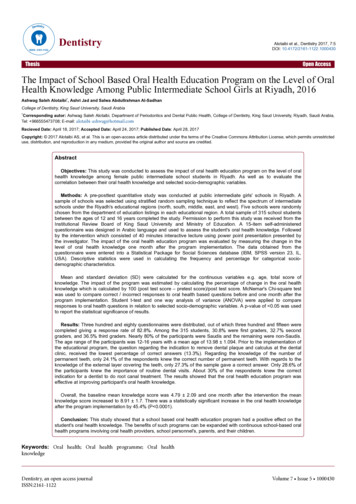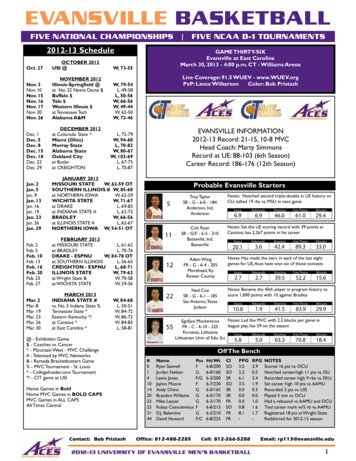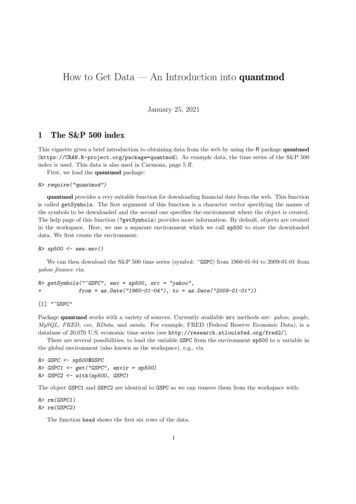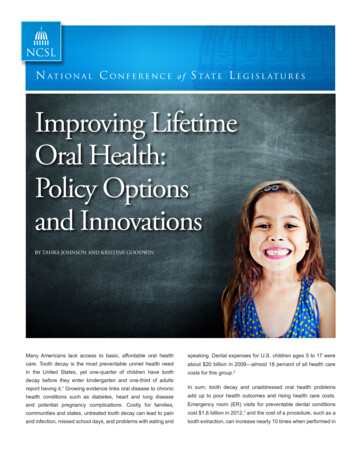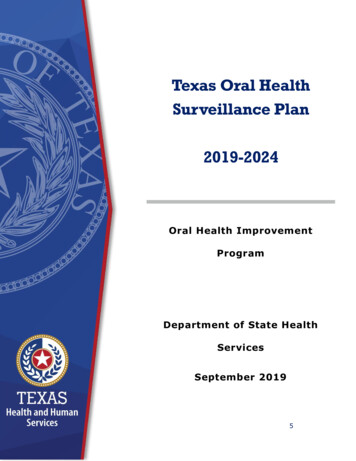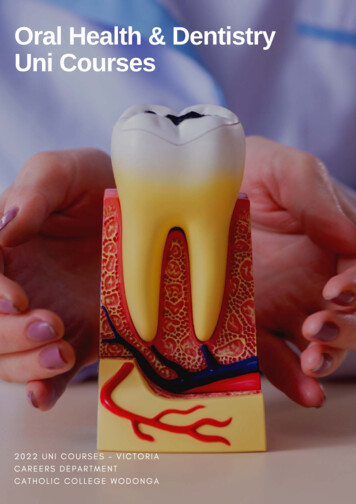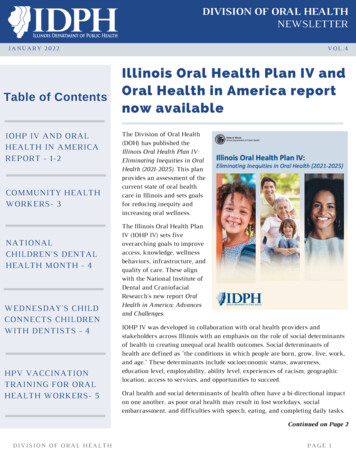
Transcription
DIVISION OF ORAL HEALTHNEWSLETTERJANUARY 2022Table of ContentsIOHP IV AND ORALHEALTH IN AMERICAREPORT - 1-2COMMUNITY HEALTHWORKERS- 3NATIONALCHILDREN'S DENTALHEALTH MONTH - 4WEDNESDAY'S CHILDCONNECTS CHILDRENWITH DENTISTS - 4HPV VACCINATIONTRAINING FOR ORALHEALTH WORKERS- 5VOL.4Illinois Oral Health Plan IV andOral Health in America reportnow availableThe Division of Oral Health(DOH) has published theIllinois Oral Health Plan IV:Eliminating Inequities in OralHealth (2021-2025). This planprovides an assessment of thecurrent state of oral healthcare in Illinois and sets goalsfor reducing inequity andincreasing oral wellness.The Illinois Oral Health PlanIV (IOHP IV) sets fiveoverarching goals to improveaccess, knowledge, wellnessbehaviors, infrastructure, andquality of care. These alignwith the National Institute ofDental and CraniofacialResearch's new report OralHealth in America: Advancesand Challenges.IOHP IV was developed in collaboration with oral health providers andstakeholders across Illinois with an emphasis on the role of social determinantsof health in creating unequal oral health outcomes. Social determinants ofhealth are defined as "the conditions in which people are born, grow, live, work,and age." These determinants include socioeconomic status, awareness,education level, employability, ability level, experiences of racism, geographiclocation, access to services, and opportunities to succeed.Oral health and social determinants of health often have a bi-directional impacton one another, as poor oral health may result in lost workdays, socialembarrassment, and difficulties with speech, eating, and completing daily tasks.Continued on Page 2DIVISION OF ORAL HEALTHPAGE 1
DIVISION OF ORAL HEALTHNEWSLETTERJANUARY 2022Continued from Page 1We are all challenged withdeveloping policies, collaborations,programs, and processes thatimprove the oral and overall healthof Illinoisans.IOHP IV is now available on theDOH website h-plan-iv.htmlOral Health in America: Advancesand Challenges was released inDecember 2021 and documents thecontinued inequities in oral health,many of which are based on age,economic, geographic, and othervariables. This report was writtenand edited by luminaries in the oralhealth field and again offerslearnings, ideas, and specificrecommendations that will improvethe oral health of individuals,communities, the state, and thenation.In this updated assessment of oral health in America,bacterial-mediated oral conditions are tied to overall healthand well-being, social and economic success, and qualityof life. The report highlights opportunities to improveaccess to oral health care through workforce innovations,collaborations across professional and lay groups, andbringing health promotion and prevention messagingVOL.4The report also challenges us toconnect pain, mental health, andsubstance abuse to oral conditionsand find ways to support and toprovide timely care that addressesthis constellation of challenges.The report offers three importantcalls to action that will significantlyimprove oral health. Many of theseideas mirror oral health findings inIllinois and recommendations inIOHP IV. They include:To significantly improve thenation’s oral health, policychanges are needed to reduce orto eliminate social, economic,and other systemic inequitiesthat affect oral health behaviorsand access to care.To improve oral health for morepeople, dental and other healthcare professionals must worktogether to provide integratedoral, medical, and behavioralhealth care in schools,community health centers,nursing homes, and medical caresettings, as well as dental clinics.To strengthen the oral health workforce, it isnecessary to diversify the composition of the nation’soral health professionals, address the cost of educatingand training the next generation, and ensuring astrong research enterprise dedicated to improving oralhealth.The whole of Oral Health in America and fact sheets areFor questions,comments,and to highlight your work onavailable side the walls of the traditional dental office.Illinois Oral Health Plan IV, please contact us atDPH.OralHealth@illinois.gov.For questions, comments, and to highlight your work on IllinoisOral Health Plan IV, contact us atDPH.OralHealth@illinois.gov.DIVISION OF ORAL HEALTHPAGE 2
DIVISION OF ORAL HEALTHNEWSLETTERJANUARY 2022VOL.4Community health workers receive oral health training,reach out to underserved communitiesTyra Jones has always had aheart for helping others. Shebegan her journey as acommunity health worker(CHW) and now serves as theEducational Lead for SIU’sOffice of Community Care. Asa CHW, Jones would hit thepavement to bring the mostunderserved patients into clinics and connect them withneeded resources. “We are essential,” she said of CHWs,“because there's people out here who are in the street andin marginalized areas that need services. We don’t waitfor the patient to come into our agency, we’re going out toget them.”According to the American Public Health Association, acommunity health worker is a frontline public healthworker who is trusted member of the community served.CHWs find medical and dental homes for patients,connect them with social services, and provide educationto help patients take charge of their health. For Jones,this means being “the hands and feet of the doctors.”“[We] create relationships with people that a physician orsomebody may not have time to cultivate,” she said. “It’smore than just keeping people out of the emergency room.It’s helping people who need food, helping people whoneed housing. It’s helping people who have beendevastated by life get hooked up with counseling services.”In 2019, a Heath Resources and Services Administration(HRSA) workforce grant to IDPH allowed for an oralhealth module to be added to the SIU School of Medicinecurriculum for CHWs. The module includes informationabout oral hygiene, oral diseases, the relationship betweenoral health and overall health, and overcoming commonbarriers to good oral health. To date, 139 CHWs have beenDIVISION OF ORAL HEALTHeducated in oral health concepts and 93% of them work orlive in a dental health professional shortage area.“When we introduced oral health to our ECHO curriculum,it was like a lightbulb went off.” said Jones. "We should havebeen doing this all along.” Many of her patients had neverlearned about the importance of going to a dentist or takingcare of their oral health. “They need to know that it’s just asimportant as anything else that they may be dealing with,”she said.Jones’ training with oral health has helped her better serveand educate her patients. She described one patient who hada toothache but was wary of seeing a dentist because shehad no prior experience with them. Jones reassured her andexplained what the dentist would do. Afterward, the clientproudly carried a toothbrush in her bag and switched fromsoda to water to prevent further dental issues.“It just takes being aware and having that education to sharewith your patients. I was able to talk to my patient about hervisit. She and I visited the dentist together. This encouragedher and motivated her,” said Jones.In the future, Jones would like to implement specializedtraining for CHWs interested in oral health. She imaginessending them out to educate and to advocate for oral healthand care for patients who need more and complicated care.“We do have some CHWs who are interested in more of thetechnical side of oral health,” she said. “With furthertraining, they would become experts for these patients.”The next CHW oral health trainings are tentativelyscheduled for February 17, (in Spanish) and Feb. 23 (inEnglish). Reach out to DPH.OralHealth@illinois.gov forregistration and more information.For questions about the CHW program, Tyra Jones canbe reached at tjones83@siumed.edu.PAGE 3
DIVISION OF ORAL HEALTHNEWSLETTERJANUARY 2022VOL.4National Children's Dental Health Month promotes sealant useFebruary is National Children's Dentalput on as soon as they appear in theHealth Month. The American Dentalmouth to protect them from cavities. ThisAssociation (ADA) has announced thatis typically between ages 6 and 11-12 yearsthe theme for 2022 is "Sealants Makeof age.Sense."Educational and promotional materialsDental sealants are thin coatings appliedfor National Children's Dental Healthto the chewing surfaces of the backMonth, including posters, activities, and ateeth to prevent decay. They stop 80% ofprogram planning guide, are available atdental caries/cavities from starting inhttps://www.ada.org/resources/communitthe back teeth, where 9 in 10 cur. Molar teeth should have a sealanthealth-month.Group addresses urgent dental needs in Wabash CountyIOHP IVObjective 3.Bsets a goal toincrease oralhealth knowledge,promotion, prevention, andappropriate referrals bynon-oral health carepersonnel. Wednesday'sChild is one example of howIllinois communities canwork towards this goal.Like many rural countiesWard stressed that many families experience barriers toin Illinois, Wabashdental access. "These families work, and if they don’tCounty is a dental healthwork, maybe they don’t have the transportation or theprofessional shortagemoney to buy the gas to get out of town,” she said. In thesearea for low-incomecases, Wednesday's Child Board members often givepatients, with the nearestfamilies a ride themselves.Medicaid-accepting dentalclinic more than 30 milesaway. Wednesday's Child,a nonprofit group, ishelping to address thisissue for low-incomechildren. They providereferrals, funding, and transportation for childrenexperiencing dental emergencies.Sandra Ward, the chair of Wednesday's Child Board, hasbecome passionate about meeting the dental needs ofchildren in her community. “If the child has a toothache,and it’s disrupting their school—and of course it’s disruptingtheir health—then we’ll do whatever it takes to get that childtaken care of,” she said.DIVISION OF ORAL HEALTHThe Wednesday's Child Board consists of representativesfrom the local school district, health department, hospital,as well as local dentist practices, nonprofits, and banks.For Ward, this collaboration is key. “Everyone comesfrom a different background, but their background isimportant to our community," she said. “If you needsomething done, they’ll come together and get it done.”This year, 16 children have received emergency carethrough the group's advocacy. Ward and other communitymembers successfully advocated to bring an in-schooldental provider to the district. Looking forward, she wouldlike to see more preventative services and education,particularly for young children. "If we could catch thembefore preschool, it would help. That’s our goal," she said.PAGE 4
DIVISION OF ORAL HEALTHNEWSLETTERJANUARY 2022VOL.4IDPH to host webinar training on HPVvaccination for oral health providersOn January 26, IDPH's Comprehensive Cancer Control Program andDivision of Oral Health will host a webinar entitled “Oral HealthPractitioners and Cancer Prevention through HPV Vaccination.” Theevent will take place via Webex from 12-1pm CST. The webinar aims toimprove oral health professionals’ understanding of current humanpapillomavirus (HPV) policies, guidelines, and resources and to help themdevelop strategies to promote HPV vaccination and to make referrals foreligible patients.Have you visited the IDPHDivision of Oral Healthweb page lately?Each year, more than 33,000 Americans die from HPV-related cancers,and HPV-linked oropharyngeal cancer cases are increasing. The HPVvaccine is highly effective at preventing infection and related cancers.Healthy People 2030 aims to increase the HPV vaccination rate inadolescents ages 13-15 to 80%. In Illinois, the current vaccination rate isTake a look at these great resources:Illinois Public Health Care MapFind data on ED visits,dental insurance rates,barriers to care, and dentistto-population rates50.1% for this population. HPV vaccination is recommended for childrenat age 11 or 12, or adults up to age 26 who have not yet been vaccinatedagainst HPV.Dr. Sharon Perlman, one of the webinar speakers, will emphasize theimportance of oral health workers' involvement in this effort. “Oralhealth care professionals have the power to prevent cancer by promotingCareers in Oral Health CareJob outlooks anddescriptions for fivecategories of oral healthworkersOral Health Coloring BookAvailable in Englishand Spanishthe HPV vaccination,” she said. “This training will outline easy-toimplement strategies for all members of the dental team and the oralhealth community to play an active role in reducing the incidence of thisdevastating cancer.”The webinar will also feature Michael P West, J.D., who is a survivor ofStage IV throat cancer, and Christopher Morrow from the IDPH Divisionof Immunization. West will speak about the significant challenges thatpatients fighting oropharyngeal cancers often face.Visit today nwellness/oral-healthOne hour of continuing education will be offered to dentists and registereddental hygienists, provided they register individually. Participants mayregister at https://illinois.webex.com/illinois/j.php/RGID rca41dade3b53ed1a5df5f0f509a18029. To learn more about oral health providers' rolein preventing HPV-related cancers visit the National HPV VaccinationRoundtable’s resource guide for dental providers.DIVISION OF ORAL HEALTHPAGE 5
Medicaid-accepting dental clinic more than 30 miles away. Wednesday's Child, a nonprofit group, is helping to address this issue for low-income children. They provide February is National Children's Dental Health Month. The American Dental. Association (ADA) has announced that. the theme for 2022 is "Sealants Make Sense." Dental sealants are .
